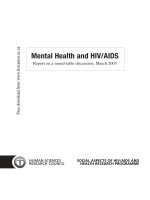Mental Health and Education Decisions: CEE DP 136 pdf
Bạn đang xem bản rút gọn của tài liệu. Xem và tải ngay bản đầy đủ của tài liệu tại đây (1.63 MB, 70 trang )
CEE DP 136
Mental Health and Education Decisions
Francesca Cornaglia
Elena Crivellaro
Sandra McNally
February 2012
Published by
Centre for the Economics of Education
London School of Economics
Houghton Street
London WC2A 2AE
© F. Cornaglia, E. Crivellaro and S. McNally, submitted February 2012
All rights reserved. No part of this publication may be reproduced, stored in a retrieval system
or transmitted in any form or by any means without the prior permission in writing of the
publisher nor be issued to the public or circulated in any form other than that in which it is
published.
Requests for permission to reproduce any article or part of the Working Paper should be sent to
the editor at the above address.
The Centre for the Economics of Education is an independent multidisciplinary research centre.
All errors and omissions remain the authors.
Executive summary
Although poor mental health has often been correlated with poor
educational attainment and/or dropping out of education, there
have been few longitudinal studies on this subject. In this paper,
we investigate this issue using a recent longitudinal study of young
people in England. England is a very interesting country to under-
take such an investigation because both poor mental health and a
high drop-out rate of young people are known to be important by
international standards.
The Longitudinal Study of Young People in England allows us to
measure mental health at age 14/15 and again at age 16/17. This is
measured using the General Health Questionnaire (GHQ12), which
is a screening instrument used to detect the presence of symptoms
of mental illness and depression in particular. We associate poor
mental health with examination performance (in GCSE exams) at
age 16 and with the probability of being observed as being “not in
education, employment or training” at age 17/18.
Detailed specifications suggest that “poor mental health” (i.e. be-
ing above a threshold considered as “at risk” according to the GHQ)
is associated with lower examination performance of between 0.083
and 0.158 standard deviations for boys and girls respectively. Al-
though these associations might conceivably be reflecting the influ-
ence of unmeasured variables, it is notable that they are very strong
even controlling for a very rich set of controls.
We use a well-known method (proposed by Graetz (1991)) to
decompose this measure of “poor mental health” into its component
parts. These are “anxiety and depression” – related to excessive
worrying and difficulty controlling this worrying; “anhedonia and
social dysfunction” – related to reduced interest or pleasure in usual
activities; and “loss of confidence or self-esteem”. We find that “loss
of confidence or self-esteem” drives the association between poor
mental health and exam results for boys. For girls this factor is also
important but the association is stronger for “anhedonia and social
dysfunction”. The factor which captures worrying does not seem to
be relevant when other controls are included.
“Poor mental health” is positively associated with the probability
of being “not in education, employment or training” (NEET). It
increases the probability of NEET by 2.7 and 3.3 percentage points
for girls and boys respectively after detailed controls are added. This
association is high in the context of overall NEET rates of 10.6%
and 7.6% for boys and girls in this sample. The association is little
influenced by controlling for exam performance at age 16. This is
surprising given that one might expect the influence of poor mental
health on NEET to operate through exam performance.
We investigate whether these associations are influenced by con-
trolling for past behaviour. For example, mechanisms through which
poor mental health might influence exam performance and the prob-
ability of being NEET include substance abuse and playing truant
from school. We show that these mechanisms have a potential role to
play in understanding the relationship between poor mental health
and exam performance. However, they have no role to play in un-
derstanding the relationship between poor mental health and the
probability of being NEET at a young age (except via exam perfor-
mance at GCSE).
This paper helps documenting the importance of the association
between poor mental health, educational attainment and subsequent
dropping-out behaviour. It suggests (but does not prove) that there
could be a causal mechanism. Thus programmes aimed at improv-
ing the mental health of adolescents may be very important for im-
proving educational attainment and reducing the number of young
people who are “NEET”.
Mental Health and Education Decisions
Francesca Cornaglia
Elena Crivellaro
Sandra McNally
1. Introduction 1
2. A Brief Literature Review 5
3. Data 9
The GHQ 11
Predicting poor mental health 17
4. Conceptual Framework 19
5. Results 25
Mental health and examination performance at age 16 25
Mental health and the probability of being “Not in Education,
Training or Employment” (NEET) 31
Potential mechanisms 37
6. Conclusion 42
References 45
Appendices 49
Acknowledgments
Francesca Cornaglia is a Lecturer in Economics & Finance at Queen Mary University of London
and a Research Associate at the Centre for Economic Performance (CEP), London School of
Economics. Elena Crivellaro is a PhD candidate in economics at the University of Padua. Sandra
McNally is a Research Fellow and Director of the Education & Skills Programme at the Centre for
Economic Performance, London School of Economics and Deputy Director of the Centre for the
Economics of Education.
The author would like to thank seminar participants at the LSE CEE seminar and at the “Health
and Human Capital” workshop in Mannheim ZEW. We are grateful for the comments and advice
of Richard Murphy and Matteo Cella.
1 Introduction
Poor mental health in childhood is strongly linked to poor men-
tal health later in life and has been shown to have a serious impact
on life chances (Richard and Abbott, 2009). Mental health prob-
lems may impact on human capital accumulation by reducing both
the amount of schooling and the productivity level, which may in
turn have lifelong consequences for employment, income and other
outcomes (Eisenberg, Golberstein, and Hunt, 2009). Although the
link between education and poor mental health has long been es-
tablished, it has not often been examined in large-scale longitudinal
studies. In this paper, we look at this issue in the context of a very
recent and large scale study of adolescents in England. England is
a particularly interesting country for analysing this issue because of
a notably bad performance both on measures of child wellbeing and
early drop-out from full-time education. For example, the UK made
headlines in the last couple of years for ranking 24th out of 29 Eu-
ropean countries on a league table of child wellbeing (Bradshaw and
Richardson, 2009). The “long tail” in the educational distribution
has long been known to be a feature of the UK labour force and
remains the case for younger cohorts. A relatively high proportion
of young people end up classified as “not in education, employment
or training” (NEET). The 2007 figures from the OECD suggests
that the UK ranks 21st out of 25 OECD countries in this respect
1
(OECD, 2010). Specifically, 11 per cent of 11-18 year olds are not
in education, employment or training. This is similar to Italy and
Spain but very different from countries such as Germany, France
and the US where the relevant statistics are 4.2%, 5.8% and 6.3%
respectively.
To what extent is poor mental health and low educational at-
tainment/ drop-out linked? Clearly the association can operate in
both directions. From a policy perspective, one would like to know
the causal influence of poor mental health on these outcomes. This
is notoriously difficult to establish and most research addresses the
association rather than the causal impact. The latter can only be es-
tablished by experiments (which can be difficult to generalise from)
or from techniques that allow one to use “exogenous variation” in
mental health to predict its causal impact on later outcomes. Re-
cent work by Ding and Lehrer (2007) makes some progress in this
direction by using genetic markers. However, such data are hard
to come by and not uncontroversial since genes may impact on be-
haviour through more than one channel. In general, it is difficult to
argue that indicators of mental health are exogenous because they
are likely to be influenced by life events that are not fully mea-
sured in surveys. Nonetheless, it is still useful to know about the
association between poor mental health and educational outcomes
as this gives some information about the likely importance of men-
tal health compared to other contributing factors (e.g. school or
2
family characteristics). It is of interest to see whether such indica-
tors continue to have an influence after controlling for many other
factors that might explain educational outcomes. Moreover, it is
interesting to see to what extent a simple screening device (like the
12 item General Health Questionnaire, used in this paper) is use-
ful for predicting negative outcomes even after controlling for many
observable characteristics. Such indicators might be useful for prac-
titioners at school as well as for researchers, particularly since a large
amount of mental health problems are thought to go unrecognised
and untreated (Richard and Abbott, 2009). Also, early-onset men-
tal disorders tend to co-occur in a complex and poorly understood
patterns of comorbidity (Kandel et al. 1999).
The General Health Questionnaire (GHQ) is a screening instru-
ment designed for use in general populations to detect the pres-
ence of symptoms of mental ill-health and depression in particular
(Goldberg, 1972.). It has been extensively used in the psychological
literature and is regarded as one of most reliable indicators of psy-
chological distress or disutility (Argyle, 1989). The 12 item version
of the GHQ (GHQ-12) is based on the questions that provided the
best discrimination among the original criterion groups. Although
most studies use the overall GHQ score as an indicator of mental
health, it can be useful to separate the indicator into different fac-
tors as they may not all work in the same direction. For example, at
lower levels anxiety can actually be productive (Sadock and Sadock,
3
2000). Graetz (1991) found years of education to be positively corre-
lated with anxiety but negatively correlated with loss of confidence.
One of the contributions of this study is to look not only at the
impact of an overall measure of mental health, but also to look at
how the different components of the GHQ measure relate to edu-
cational attainment and the probability of moving into inactivity
at an early age. We find strong patterns of association with re-
spect to the overall measure, particularly for girls. However, we also
find that different components are not equally important and that
the effects of ’anxiety’ and the other factors are indeed associated
with outcomes in opposite directions. Secondly, we contribute by
saying something about potential mechanisms through which poor
mental health may impact on outcomes. For example, poor mental
health may impact on later outcomes by intermediary choices such
as insufficient investment in effort (e.g. playing truant) and self-
medication (e.g. substance abuse). We attempt to say something
about the likely importance of these factors. Finally, we perform our
analysis using a very recent cohort of young people where there is
longitudinal data - and in a country where both poor mental health
and early drop-out are known to be very big problems by interna-
tional standards. It is rare to have data for such a recent cohort
(aged 14/15 in 2004) and this might be important because adoles-
cent emotional problems and conduct disorder are known to have
become more prevalent in recent decades (Collishaw et al. 2004).
4
2 A brief literature review
The relationship between mental health and education has been
explored in both the psychological literature and the economic lit-
erature.
There are many small-scale studies in the psychological literature
looking at the relationship between indicators of mental health and
educational outcomes. The first study to examine the educational
consequences of mental disorders in a national sample for the US
was by Berslau et al. (2008). They find strong associations be-
tween child-adolescent mood, anxiety, substance use and conduct
disorders with termination of schooling prior to each of three ed-
ucational milestones (high school graduation, college entry among
school graduates and completion of four years of college among col-
lege entrants). A more recent study also finding large effects (though
among a broader set of disorders) is by Berslau et al. (2008). They
find that the proportion of school terminations attributable to men-
tal disorders was largest for high school graduation (10.2%) but also
meaningful for primary school graduation, college entry, and college
graduation. A disadvantage of these studies is that they are cross-
sectional and rely on retrospective questions of ’early onset’ mental
health indicators.
Within the psychological literature, longitudinal studies are rare.
An example is the study by Fergusson and Woodward (2002). They
5
find that the relationship between adolescent depression and sub-
sequent educational underachievement could be fully explained by
a range of social, familial and personal factors. Johnson, Cohen,
and Dohrenwend (1999) come to a similar conclusion with regard
to the association between depression/anxiety disorders and subse-
quent staying on decisions.
The economic literature has only fairly recently begun to consider
the relationship between mental health and educational outcomes.
A strength of the contribution made by economists is that typically
studies are longitudinal and have big sample sizes.
Currie and Stabile (2006) and Fletcher and Wolfe (2008) both fo-
cus on the relationship between ADHD
1
and subsequent educational
attainment and find evidence of a strong negative association. This
is important because ADHD is one of the most common chronic
mental health problems among young children together with con-
duct disorder and anxiety. However, there are other mental health
problems that become more prevalent in early adolescence such as
depression. An interesting observation is that the sex difference in
mental health problems is reversed in childhood and in early ado-
lescence. For example, depression (and other types of mental health
problems) are more prevalent in males in childhood whereas the op-
posite is true among adolescents and adults (Peterson et al. 1993)
2
1
Attention deficit hyperactivity disorder.
2
This finding has been commonly reported in the psychological literature for some time
(e.g. Eme 1979; Gove and Herb 1974; Locksley and Douvan 1979).
6
and research on this issue suggests that this is not related to fac-
tors such as response bias on questionnaires or greater openness
to acknowledging psychological difficulties. Furthermore depressive
symptoms increase (for boys and girls) through early adolescence
and the finding that girls suffer more than boys has been consis-
tently documented in many countries (Seiffge-Krenke and Stemm-
ler, 2003). This is true for both clinical levels of depression and
subclinical levels such as depressive symptoms and depressive mood
(Cicchetti and Toth, 1998). Theories about why this might be the
case relate to the timing of puberty, different coping resources, and
reaction to stressful life events .
Using longitudinal data, Fletcher (2008) finds a robust negative
relationship between depression in high school and subsequent ed-
ucational attainment, even after controlling for a range of factors.
In later work, he finds that the relationship is not very sensitive to
the inclusion of sibling fixed effects (Fletcher, 2010). These studies
pertain to a recent cohort (students in grades 7-12 in 1994-1995) and
are for the US. The timeframe of the research could be important for
what he finds because the prevalence of mental health problems has
increased over time. In fact, there has been a rise internationally in
the prevalence of depression (Cross-National Collaborative Group,
1992). Furthermore, work based on the British birth cohorts and
the British Child and Adolescent Mental Health Survey suggests a
rise in adolescent emotional problems and conduct disorder from
7
the mid-1970s up to recent times (Callishaw et al. 2004). Fortu-
nately, we are able to look at the relationship between poor mental
health and educational outcomes for a very recent cohort of English
students (aged 14/15 in 2004).
Other recent longitudinal studies that consider the relationship
between adolescent mental health problems and educational attain-
ment have much to say about depression in particular (Ding and
Lehrer 2007; Eisenberg, Golberstein, and Hunt 2009; Fletcher 2008)
and all suggest that this has a strong negative impact on educa-
tional attainment. Ding and Lehrer (2007) and Fletcher (2008) look
at this separately by gender and find that effects are only impor-
tant for girls. The paper by Fletcher (2008) is closest to our paper
in terms of the age group of students, outcomes and methodology
(although he has a different measure of mental health, and the pa-
per relates to a different time and country). He comments that it
is not possible to provide evidence on the mechanism behind the
association between depression and dropping out of high school be-
cause many of the choices that adolescents make before dropping
out of school (e.g. skipping school) are not adequately captured in
the data set. We are fortunate to be able to say something about
these potential mechanisms because relevant questions are asked in
the survey that we use.
8
3 Data
We use data from the Longitudinal Survey of Young People in
England (LSYPE). This is a longitudinal data set which surveyed
children aged between 13 and 14, beginning in 2004, for a total of
around 14,000 young people. Parents are also surveyed and that
data has been linked with administrative data on pupil test scores
(including prior performance) and school-level information. Pupils
(and parents) are surveyed each year up to age 18/19 (so far). The
data set contains a very rich set of information about each young
person. For example, it provides information on educational attain-
ment, school information, family background as well as attitudes and
behaviour. Young people respond to the 12-item General Health
Questionnaire (GHQ) on two occasions - when the they are aged
14/15 (i.e. Wave 2) and again when they are aged 16/17 (i.e. Wave
4). We restrict our sample to people who answer all the GHQ ques-
tions in both waves. About 75% of young people answered all the
GHQ questions in each Wave. 60% of young people answered all the
questions in both waves and this reduces the sample to 8,122.
3
The GHQ measure will be further described in the next section (a
detailed description is provided in Appendix A1 and A2). We only
retain observations for which we have valid test scores. The sample
size is then 7,832. Descriptive statistics for the variables used in our
3
We have replicated our analysis when including people who answered 11 out of the 12
questions. Our results are not sensitive to this increase of our sample.
9
analysis are shown in Appendix A1 (Table A1.1 and A1.2). The
sample used is similar to the full sample in many respects (such
as the proportion ’not in educaion, employment or training’ at age
17/18; parental qualifications and work status; family structure).
For the most part, differences between the samples are quite small
- although the sample used is a little better performing than the
full sample in terms of exam results and in terms of socio-economic
status (income and parental education). The samples are compared
in Table A1.2.
Our outcome variables are the (standardized) test score at age
16 and whether the person is classified as ’not in education, employ-
ment or training’ (i.e. NEET) in Wave 5 (i.e. at age 17/18). The
age 16 test score comes from the GCSE exam (General Certificate
of Secondary Education) which all students in the UK undertake
before leaving the compulsory phase of education at age 16. The
National Curriculum is organized into different Key Stages. The
GCSE exam marks the end of Key Stage 4. In many of our spec-
ifications, we control for test scores taken in national tests at the
end of primary school (the end of Key Stage 2). The examination
scores are all taken from administrative data that have been merged
to survey data. Figure 1 summarizes the main variables used in the
analysis.
10
Figure 1: LSYPE Dataset. Measures of Mental Health and Educational Attain-
ment
Figure 1: LSYPE Dataset. Measures of Mental health and Educational Attainment
Wave 1
2004
Wave 2
2005
Wave 3
2006
Wave 4
2007
Wave 5
2008
-Individual
characteristics
-Family
characteristics
Average age: 13
-GHQ Mental
health variables
Average age: 14
Potential
mechanisms
-Substance abuse
-Truancy
Average age: 15
-GHQ Mental
health variables
Average age: 16
Neet status
at age 17
Outcomes
Controls
Administrative
data:
KS4-GCSE
Point scores
3.1 The GHQ
The 12-item General Health Questionnaire (GHQ-12) is a self-
reported measure of psychological morbidity intended to detect "psy-
chiatric disorders among respondents in community settings and
non-psychiatric clinical settings" (Goldberg and Williams, 1988). It
is a measure of state which focuses mainly on the inability to carry
out normal functions and the emergence of distressing symptoms.
The GHQ-12 is a shorter version of a longer health questionnaire
(originally 60-items) assessed by the World Health Organization and
is used in studies about psychological disorders in primary health
care. Due to its brevity and its capacity to retain many desirable
psychometric properties, the GHQ-12 is widely used in clinical prac-
tice, epidemiological research and psychological research (Goldberg
et al. 1997; Graetz 1991; Thomas, Benzeval, and Stansfeld 2005;
11
Sweeting et al. 2009). It is also a very commonly used measure of
individual well-being by economists in the UK literature (e.g. Clark
and Oswald 1994; McCulloch 2001; Wigging et al. 2004; Gardner
and Oswald 2007).
4
The questionnaire consists of 12 statements about aspects of well-
being relating to worry, tension or sleeplessness. The respondent is
asked to report his/her status over the past four weeks compared to
what he/she considers “usual”. There are six items that are positive
descriptions of mood states (e.g "felt able to overcome difficulties"),
and six that are negative descriptions of mood states (e.g. "felt like
a worthless person"). The respondent states whether he/she is ex-
periencing the symptom “much less than usual”, “less than usual”,
“the same as usual” or “more than usual” (see Appendices 2 and 3).
The most common scoring methods are as follows:
1. a Likert score, which assigns each response a value from zero to
three, with zero indicating the highest level of well-being and
three indicating the lowest. The answers are then summed to
form the overall GHQ measure of psychiatric illness or mental
well-being (total range 0-36) .
4
Many of these studies use data from the British Household Panel Survey (BHPS) since
it is one of the most detailed panel surveys which contains GHQ data. McCulloch (2001) uses
the GHQ12 as an outcome of individual adversity associated with a census-based indicator of
deprivation. Clark, Georgelli, and Sanfey (2001) use the GHQ to show that the unemployed
have lower levels of mental well-being compared to working people. Similarly, Thomas, Ben-
zeval, and Stansfeld (2005) use the GHQ as an outcome variable to measure the impact of
different kinds of employment transitions (into various forms of non-employment) on psycho-
logical wellbeing. The GHQ has also been used widely in the literature on job satisfaction
(Gardner and Oswald 2007, Callan et al. 2001 ).
12
2. a binary score system which assigns binary values to the re-
sponses from each question (where 1 indicates a low level of
psychological well-being). The total score (over all items) varies
between 0 and 12.
In both cases, the scoring is done such that high numbers indi-
cate decreased levels of psychological well-being. Psychologists re-
fer to being over a given threshold (beyond which the respondent
is deemed to have mental health problems) as “caseness”. When
the binary score system is used, thresholds commonly applied in
the literature are two, three and four positive items. We apply
the most stringent threshold to indicate mental health problems or
“risky cases” (i.e. 0-3: no ill-health; 4-12: high probability of com-
mon mental disorders).
Many studies have analysed the dimensionality of the GHQ, as-
sessing psychological morbidity in two or three dimensions rather
than as a unidimensional index. The most common factorization
is the one by Graetz (1991). He has proposed a three-dimensional
model of the GHQ where questions can be used to create three
distinct factors: Factor 1: “Anxiety and depression”- related to ex-
cessive worrying and difficulty controlling this worrying, Factor 2:
“Anhedonia and social dysfunction”- related to reduced interest or
pleasure in usual activities, and Factor 3: “Loss of confidence or
self-esteem”. This is a useful distinction since different aspects of
13
GHQ-12 may be associated with behaviour in different ways (po-
tentially in opposite directions). In our analysis we consider both
the overall measure of mental health (both over a certain threshold
and measured continuously), and these different components.
In the survey, the GHQ questions are asked directly to the young
person in Waves 2 and 4.In Table 1 we show summary statistics for
key variables in our analysis.
Table 1: Main variables
Variable
Description
Boys
Girls
Boys
at risk
Girls
at risk
Panel A: Mental Health variables*
GHQ at risk
GHQ 12 score >= 4.
Risky threshold for GHQ12 “caseness”.
0.110
(0.31)
0.248
(0.43)
1
(0)
1
(0)
GHQ Likert (0-1)
GHQ expressed in a continuous range [0-1].
The 12-GHQ questions are measured with the Likert
scoring method (1-2-3-4 ) and then divided by 36.
0.236
(0.13)
0.312
(0.17)
0.500
(0.13)
0.543
(0.14)
Anxiety and
Depression **
Continuous values ranging from 0-1.
Includes four „negative‟ items related to anxiety and
depression.
0.235
(0.21)
0.338
(0.25)
0.615
(0.18)
0.670
(0.17)
Loss of confidence**
Continuous values ranging from 0-1
Includes two „negative‟ items related to self
confidence.
0.139
(0.21)
0.240
(0.28)
0.501
(0.29)
0.572
(0.29)
Anhedonia and Social
dysfunction. **
Continuous values ranging from 0-1.
Include six ”positive” items testing the ability to
perform daily activities and to cope with everyday
problems.
0.269
(0.12)
0.318
(0.13)
0.423
(0.16)
0.449
(0.16)
Panel B: Output variables
Standardized point
scores
GCSE Standardized point scores
Key Stage 4. (i.e. 16/17 years.)
-0.107
(1.02)
0.115
(0.96)
-0.097
(1.09)
0.060
(1.01)
Neet in W5
Not in education, employment or training at age
17/18.
0.106
0.076
0.124
0.098
*= Mental health variables collected in wave 2 (i.e. when young person is 14/15 years old). These variables are
available also in W4, see appendix for detailed descriptive statistics.
**= See appendix for the construction of these indexes.
Panel A shows that a fairly high percentage of boys and girls are
classified as “at risk” by the binary measure (at Wave 2) - 11 per cent
of boys and almost 25 per cent of girls. Girls have a higher prob-
ability of mental health problems in each of the three dimensions
14
of the GHQ (anxiety and depression, loss of confidence, anhedonia
and social disfunction). If we look at the outcome variables (panel
B), we see that both boys and girls “at risk” have lower outcomes
with regard to the test score at age 16 and the probability of being
“not in education, employment or training” than people not at risk.
However, on average girls fare better than boys (even within the
subpopulation of people “at risk”).
In Table 2 we show the proportion of boys and girls who scored
positively (i.e. indicating worry/stress) with respect to each com-
ponent of the GHQ at age 14/15 (Wave 2; columns 1 and 4), and
at age 16/17 (Wave 4; columns 2 and 5). Panel A reports the pro-
portion of adolescents who could be defined as “at risk” according
to the stringent threshold (i.e. where worry/anxiety is indicated
in the response to at least 4 out of 12 questions). We also report
results for a lower threshold - at least 2 out of 12 questions . For
comparison, we show the same data for 15 year olds from a recent
survey of Scottish children (Sweeting, Young, and West, 2009). The
comparable data are shown in columns 3 and 6. It is interesting
to observe how similar the English and the Scottish studies are in
terms of the overall incidence of poor mental health as well as for
each separate indicator.
5
Other insights from this Table are that girls report a higher level
5
Our GHQ scores are in line also with a study in the Netherlands about young people
aged 18-24 (Hoeymans, Garssen, Westert, and Verhaak, 2004). They find a ’GHQ caseness’
of 25% for young people aged 18-24, as well as higher rates for females.
15
of stress or worry than boys according to all indicators. Also, the
incidence of poor mental health increases with age.
Table 2: Comparing GHQ in the LSYPE with Scottish data.
VARIABLES
(1)
Boys
Wave 2
Age 14/15
(2)
Boys
Wave 4
Age 16/17
(3)
Boys in
Scotland
2006
Age 15
(4)
Girls
Wave 2
Age 14/15
(5)
Girls
Wave 4
Age 16/17
(6)
Girls in
Scotland
2006
Age 15
Panel A: GHQ at risk
GHQ at Risk:
standard (>=2)
15.5
22.8
21.5
32.2
38.7
44.1
GHQ at Risk:
stringent (>=4)
11
16.1
10.2
24.7
29.8
26.7
Panel B: Factor 1- Anxiety and Depression
Felt constantly under
strain
19.6
29.1
21.9
33.2
41.4
36.5
Being feeling unhappy
or depressed
14.7
18.9
18.5
29.6
32.5
37.2
Lost much sleep over
worry
11.9
17.7
16.4
24.2
31.8
29.5
Felt you could not
overcome your
difficulties
13.4
16.3
14.9
23.6
26.3
26.2
Panel C: Factor 2- Loss of confidence
Been losing confidence
in yourself
10.9
12.4
12.8
22.2
24.2
26.4
Been thinking of
yourself as a worthless
person
6.1
7.2
6.8
14.7
14.9
16.1
Panel D: Factor 3- Anhedonia and Social Dysfunction
Been feeling reasonably
happy, all things
considered (disagree)
6.5
9.1
9.7
13.6
17.1
21.7
Felt you were playing a
useful part in things
(disagree)
5.8
8.9
8.1
9.6
11.8
15.1
Felt capable of making
decisions about things
(disagree)
3.2
4.1
5.2
6.3
9.6
13.3
Been able to face up to
your problems
(disagree)
4.7
5.9
6.9
10.8
13.3
16.6
Been able to enjoy your
day-to-day activities
(disagree)
7.5
12.8
11.1
12.6
18.6
15.2
Been able to
concentrate on
whatever you are doing
(disagree)
9.7
11.7
15.4
17.6
19.4
32.0
Observations
4067
4067
1505
3765
3765
1539
16
3.2 Predicting poor mental health
Although not the main focus of our work, it is of interest to in-
vestigate how poor mental health, as measured by the GHQ, relates
to pupil characteristics. A table showing summary statistics for
variables used in our analysis for the whole sample and according
to whether young people are “at risk” is shown in Appendix Table
A1.1. We estimate a Probit model where the dependent variable
is the threshold beyond which someone might be thought of as “at
risk”. The results are reported in Appendix Table A1.3.
We have run separate regressions for boys and girls. The first
specification includes only basic controls (family income, ethnicity,
parental education). In a second specification, we include a broad
range of controls - many personal and family characteristics as well
as school level characteristics.
Results are qualitatively similar when using the continuous men-
tal health measure. One of the most striking facts is how poorly the
variables collectively explain poor mental health (no matter how we
measure it). This suggests either that the GHQ does not have much
informational content or that it simply does not correlate well with
the usual indicators found in surveys, even though the information
set is fairly rich. The main part of our analysis (and much of the lit-
erature) rejects the first explanation - it seems that the GHQ-12 does
indeed have informational content. However, poor mental health is
17
not well predicated by the usual indicators available to researchers
and to schools (e.g. knowledge of test scores, family circumstances,
socio-economic status and school characteristics).
Relatively few variables are significantly different from zero, and
this is more often the case for girls. For girls, among the vari-
ables that significantly effect the probability of having “poor mental
health” (i.e. above the critical threshold) are family income (nega-
tive), whether the young person has a disability (positive), whether
English is the main language of the household (positive), whether
the parent is in good health (negative), the age 11 test score in En-
glish (positive), whether the young person goes to an independent
school (negative). For boys, significant variables include whether the
mother works full-time (negative), age 11 test score in Science (neg-
ative), age 11 test score in English (positive), and some school-level
variables.
Although the data set used here is very rich, it is nonetheless
true that variables highlighted in the psychological literature are
probably not well captured by the included variables. For instance,
many psychological studies emphasise ’deficient active coping ca-
pacity’ as a relevant variable (Andrews et al. 1978, Seiffge-Krenke
1995 and 2000). Various other studies point to a strong associa-
tion between negative self-related cognitions and attribution styles
including low self-esteem, low self-consciousness and helplessness in
depressive adolescents (Harter and Jackson, 1993).
18









